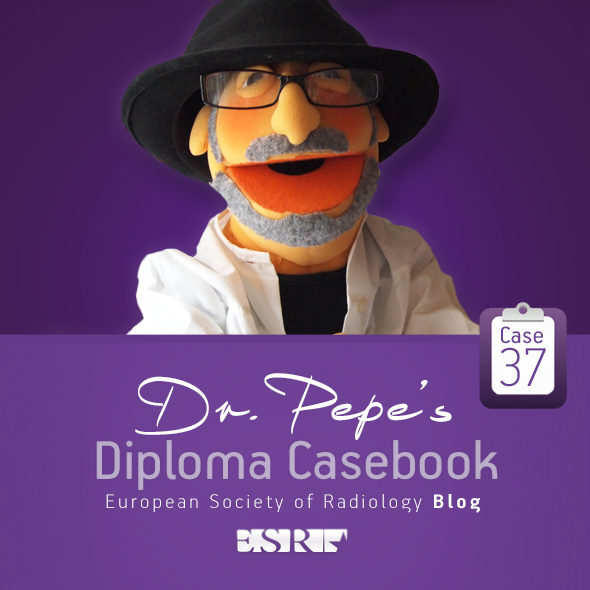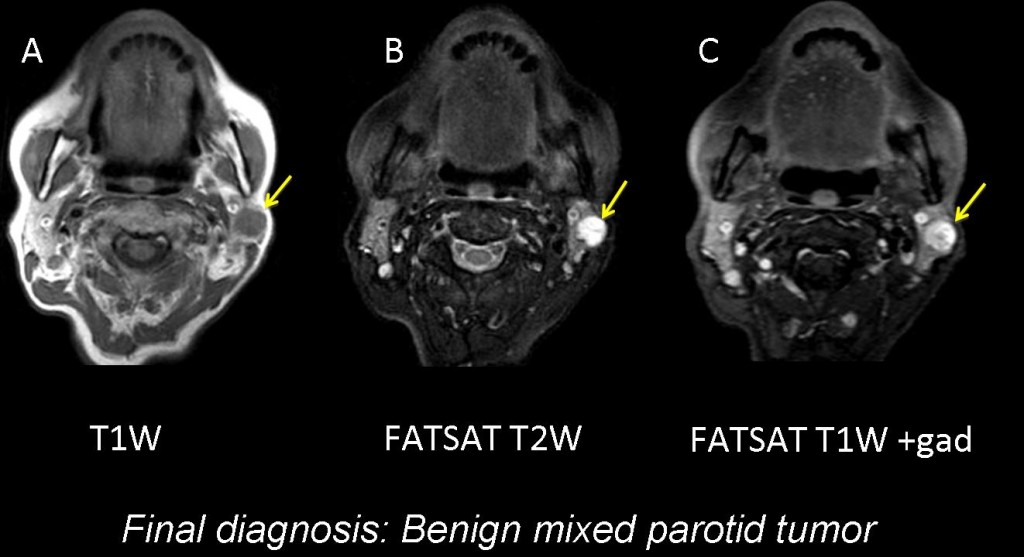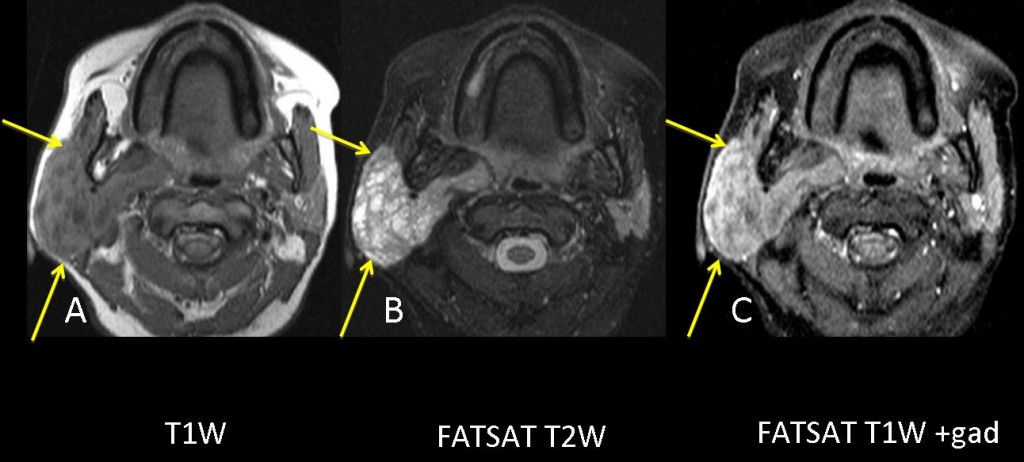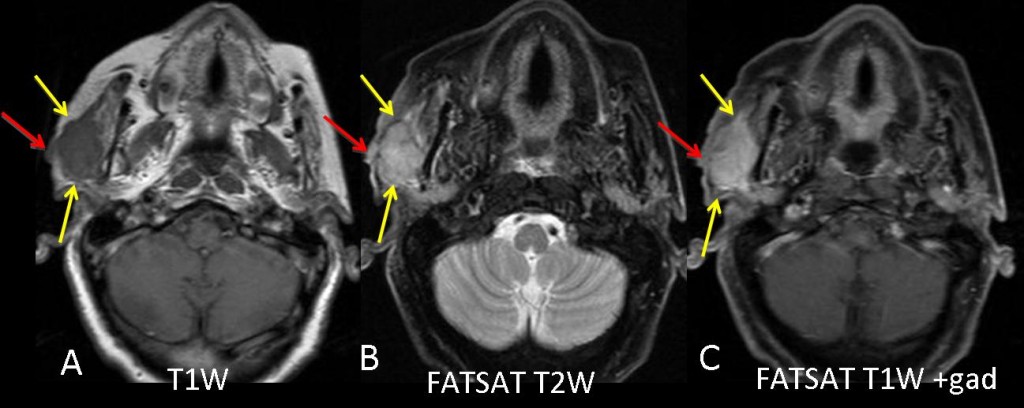Dr. Pepe’s Diploma Casebook: Case 37 – SOLVED!
Dear friends,
Presenting images of a 65-year-old asymptomatic woman with left parotid mass.
Possible diagnosis:
1. Benign mixed tumor
2. Non-Hodgkin lymphoma
3. Carcinoma
4. None of the above
Findings: well-marginated round mass in the superficial lobe of the left parotid (arrows). Hypointense on T1W image (A), uniform high signal on T2W image (B), and homogeneous enhancement with gadolinium (C). Asymptomatic masses arising from the parotid are almost always benign mixed tumours, and the imaging findings support this diagnosis.
Benign mixed tumours (pleomorphic adenoma) are the most common parotid tumours. They usually originate in the superficial lobe and occur more often in women.
On MRI, they appear as well-demarcated homogeneous masses with smooth margins that are hypointense on T1W images, hyperintense on T2W images, and show homogeneous enhancement with gadolinium. They can present dystrophic calcification and may have a low signal intensity capsule.
Aside from benign mixed tumours, the differential diagnosis of parotid tumours includes Warthin tumour, non-Hodgkin lymphoma, adenoid cystic carcinoma, mucoepidermoid carcinoma, and nodal metastasis.
Warthin tumour is the second most common benign parotid tumour. 20% are multicentric unilateral or bilateral masses with a cystic component.
Primary lymphomas account for less than 5% of parotid tumours. Patients with Sjögren disease are at an increased risk of developing B-cell non-Hodgkin’s lymphoma. Most of these tumours arise in extranodal mucosal sites, especially the salivary glands.
44-year-old woman with Sjögren disease and a right parotid mass. MRI shows enlarged right parotid with multiple intraparotid cystic lesions: hypointense on T1W image (A), hyperintense on T2W image (B), and heterogeneous enhancement with gadolinium (C). Involvement of the superficial and deep lobe of the parotid (arrows). Diagnosis: B-cell non-Hodgkin lymphoma.
Squamous cell carcinomas of the parotid are rare. They presumably arise from the Stensen duct.
Parotid nodes are the first-order nodal site for skin lesions of the upper face. It is not unusual to find metastatic intraparotid lymph node enlargement arising from primary squamous cell tumors of skin.
90-year-old woman with a painful parotid mass and skin lesion in the right parotid region. Poorly defined, superficial lobe, intraparotid mass: hypointense on T1W image (A, arrows), intermediate/hyperintense on T2W image (B, arrows) and heterogeneous enhancement with gadolinium (C, arrows). The mass extends to and comes into contact with the skin (red arrows). Diagnosis: squamous cell carcinoma.
Follow Dr. Pepe’s advice:
- The differential diagnosis of parotid masses includes benign mixed tumors, Warthin tumor, carcinoma, lymphoma, and nodal metastasis.
- Benign mixed tumors represent 60% to 70% of parotid tumors. They are more common in women and are usually unilateral with well-defined margins.
- Sjögren syndrome may be associated with non-Hodgkin lymphoma of parotid gland.
Recommended reading:
MR imaging of parotid tumors: typical lesion characteristics in MR imaging improve discrimination between benign and malignant disease. Christe A, Waldherr C, Hallett R, Zbaeren P, Thoeny H. AJNR Am J Neuroradiol. 2011 32:1202-7
CT and MR images of pleomorphic adenoma in major and minor salivary glands. Kakimoto N, Gamoh S, Tamaki J, Kishino M, Murakami S, Furukawa S. Eur J Radiol. 2009; 69:464-72. Epub 2008 Feb 21.
Case presented by Laura Oleaga, MD








T2 hyperintense, enhancing left parotid lesion. It is well defined and with lobulated margins.
The main differential in a parotid mass would be Pleomorphic adenoma (benign mixed tumor) and Warthin tumor in the benign side and Mucoepidermoid Carcinoma and Cilindroma (adenoid cystic carcinoma in the malignant side. Other possible masses include lymphoma, adenopathies, cystic lymphoepitelial lesions in HIV, mets -melanoma and branchial cleft cyst (1st branchial cleft). Also inflammatory and systemic processes can afect more diffusley theses glands.
As general features, benign lesions are usually hyperintense in T2 WI and malignant processes tend to be hypointense in T2 WI, anyway that is not always true and some pleomorphic adenomas appear hypointense in T2 and some mucoepidermoid carcinomas appear hyperintense. Cilindroma is usually ill defnied and spiculated and it characteristically spread along cranial nerves. Mucoepidermoid carcinoma tend to be encapsulated, but usually big lesions and is described to affect more freuqnetly the deep lobe of the parotid. Lymphoma can be multifocall and usually does not enahnces this avidly. You have to think in Warthin when you are in front of a cyst-like lesion with enhancing septa and when u are in front of bilateral partoid masses, it is described to have non-lobulated margins ans elipsoidal shape. I wouldn’t consider other processes.
Summarising, the most probable diagnosis would be for me by far PLEOMORPHIC ADENOMA.
Well-circumscribed mass is seen hypointense on T1W, hyperintense on FATSAT T2W and gadolinium-enhancing partially. No signs identify tissue infiltration neighborhood or local lymphadenopathy. Clinical data also go for benign (painless mass, no facial nerve involvement).
The first diagnostic option is benign mixed tumor (pleomorphic adenoma).
T. misto od adenoma pleomorfo: agli US ed ECD ha aspetti caratteristici.Perchè non avete mostrato l’esame di primo approccio?
I agree with the pleomorfic adenoma. But I I would like to ask whether there is an another lesion at the posterior part of the right parotid?!
Pleomorphic adenoma
I agree with Maria. I think that there are two lesions (one in each parotid gland) with the same MR characteristics (well-delineated masses with high signal in T2 and mild enhancement). Therefore, it could be bilateral Wharthin tumors or bilateral parotid lymph node enlargement due to skin, breast or lung carcinoma.
Taking into account Dr. Pepe’s comment I choose 1. Benign mixed tumor
Wharthin tumor – lymphoma
ADC Maps?
I think PetCT is useful in these case.
warthin mostly is not enhanced mass after iv contrast.
here we have partial enhancment and cystic components
I think is warthin
ok metastatic lymph nodes then
papillary cystadenoma lymphomatosum
There is no lesion on the right parotid gland. A small lymph node separated from the gland is seen on the right side.
There is no lesion on the right parotid. A small lymph node can be seen posterior to the right parotid.